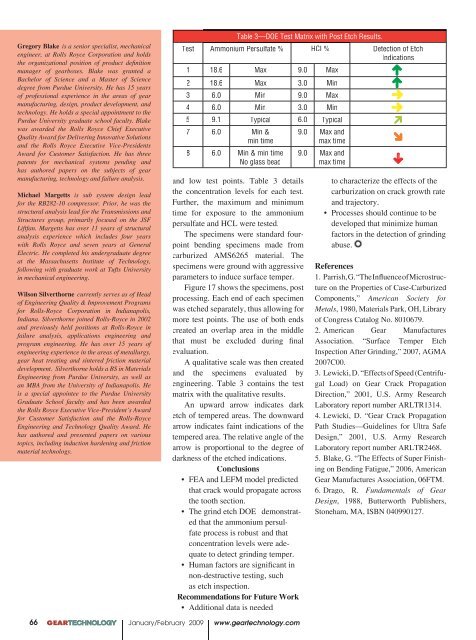Gear Failure Analysis Involving Grinding Burn - Gear Technology ...
Gear Failure Analysis Involving Grinding Burn - Gear Technology ...
Gear Failure Analysis Involving Grinding Burn - Gear Technology ...
Create successful ePaper yourself
Turn your PDF publications into a flip-book with our unique Google optimized e-Paper software.
Gregory Blake is a senior specialist, mechanical<br />
engineer, at Rolls Royce Corporation and holds<br />
the organizational position of product defi nition<br />
manager of gearboxes. Blake was granted a<br />
Bachelor of Science and a Master of Science<br />
degree from Purdue University. He has 15 years<br />
of professional experience in the areas of gear<br />
manufacturing, design, product development, and<br />
technology. He holds a special appointment to the<br />
Purdue University graduate school faculty. Blake<br />
was awarded the Rolls Royce Chief Executive<br />
Quality Award for Delivering Innovative Solutions<br />
and the Rolls Royce Executive Vice-Presidents<br />
Award for Customer Satisfaction. He has three<br />
patents for mechanical systems pending and<br />
has authored papers on the subjects of gear<br />
manufacturing, technology and failure analysis.<br />
Michael Margetts is sub system design lead<br />
for the RB282-10 compressor. Prior, he was the<br />
structural analysis lead for the Transmissions and<br />
Structures group, primarily focused on the JSF<br />
Liftfan. Margetts has over 11 years of structural<br />
analysis experience which includes four years<br />
with Rolls Royce and seven years at General<br />
Electric. He completed his undergraduate degree<br />
at the Massachusetts Institute of <strong>Technology</strong>,<br />
following with graduate work at Tufts University<br />
in mechanical engineering.<br />
Wilson Silverthorne currently serves as of Head<br />
of Engineering Quality & Improvement Programs<br />
for Rolls-Royce Corporation in Indianapolis,<br />
Indiana. Silverthorne joined Rolls-Royce in 2002<br />
and previously held positions at Rolls-Royce in<br />
failure analysis, applications engineering and<br />
program engineering. He has over 15 years of<br />
engineering experience in the areas of metallurgy,<br />
gear heat treating and sintered friction material<br />
development. Silverthorne holds a BS in Materials<br />
Engineering from Purdue University, as well as<br />
an MBA from the University of Indianapolis. He<br />
is a special appointee to the Purdue University<br />
Graduate School faculty and has been awarded<br />
the Rolls Royce Executive Vice-President’s Award<br />
for Customer Satisfaction and the Rolls-Royce<br />
Engineering and <strong>Technology</strong> Quality Award. He<br />
has authored and presented papers on various<br />
topics, including induction hardening and friction<br />
material technology.<br />
and low test points. Table 3 details<br />
the concentration levels for each test.<br />
Further, the maximum and minimum<br />
time for exposure to the ammonium<br />
persulfate and HCL were tested.<br />
The specimens were standard fourpoint<br />
bending specimens made from<br />
carburized AMS6265 mate rial. The<br />
specimens were ground with aggressive<br />
parameters to induce surface temper.<br />
Figure 17 shows the specimens, post<br />
processing. Each end of each specimen<br />
was etched separately, thus allowing for<br />
more test points. The use of both ends<br />
created an overlap area in the middle<br />
that must be excluded during final<br />
evaluation.<br />
A qualitative scale was then created<br />
and the speci mens evaluated by<br />
engineering. Table 3 contains the test<br />
matrix with the qualitative results.<br />
An upward arrow indicates dark<br />
etch of tempered areas. The downward<br />
arrow indicates faint indications of the<br />
tempered area. The relative angle of the<br />
arrow is proportional to the degree of<br />
darkness of the etched indications.<br />
Conclusions<br />
• FEA and LEFM model predicted<br />
that crack would propagate across<br />
the tooth section.<br />
• The grind etch DOE demonstrated<br />
that the am monium persulfate<br />
process is robust and that<br />
concentration levels were adequate<br />
to detect grinding temper.<br />
• Human factors are significant in<br />
non-destructive testing, such<br />
as etch inspection.<br />
Recommendations for Future Work<br />
• Additional data is needed<br />
66 00 GEARTECHNOLOGY January/February 2009 www.geartechnology.com<br />
Table 3—DOE Test Matrix with Post Etch Results.<br />
Test Ammonium Persulfate % HCI % Detection of Etch<br />
Indications<br />
1 18.6 Max 9.0 Max<br />
2 18.6 Max 3.0 Min<br />
3 6.0 Min 9.0 Max<br />
4 6.0 Min 3.0 Min<br />
5 9.1 Typical 6.0 Typical<br />
7 6.0 Min &<br />
min time<br />
8 6.0 Min & min time<br />
No glass bead<br />
9.0 Max and<br />
max time<br />
9.0 Max and<br />
max time<br />
to characterize the ef fects of the<br />
carburization on crack growth rate<br />
and trajectory.<br />
• Processes should continue to be<br />
developed that minimize human<br />
factors in the detection of grinding<br />
abuse.<br />
References<br />
1. Parrish, G. “The Influence of Microstructure<br />
on the Properties of Case-Carburized<br />
Components,” American Society for<br />
Metals, 1980, Materials Park, OH, Library<br />
of Congress Catalog No. 8010679.<br />
2. American <strong>Gear</strong> Manufactures<br />
Association. “Surface Temper Etch<br />
Inspection After <strong>Grinding</strong>,” 2007, AGMA<br />
2007C00.<br />
3. Lewicki, D. “Effects of Speed (Centrifugal<br />
Load) on <strong>Gear</strong> Crack Propagation<br />
Direction,” 2001, U.S. Army Research<br />
Laboratory report number ARLTR1314.<br />
4. Lewicki, D. “<strong>Gear</strong> Crack Propagation<br />
Path Studies—Guidelines for Ultra Safe<br />
De sign,” 2001, U.S. Army Research<br />
Laboratory report number ARLTR2468.<br />
5. Blake, G. “The Effects of Super Finishing<br />
on Bending Fatigue,” 2006, American<br />
<strong>Gear</strong> Manufactures Association, 06FTM.<br />
6. Drago, R. Fundamentals of <strong>Gear</strong><br />
De sign, 1988, Butterworth Publishers,<br />
Stoneham, MA, ISBN 040990127.

















